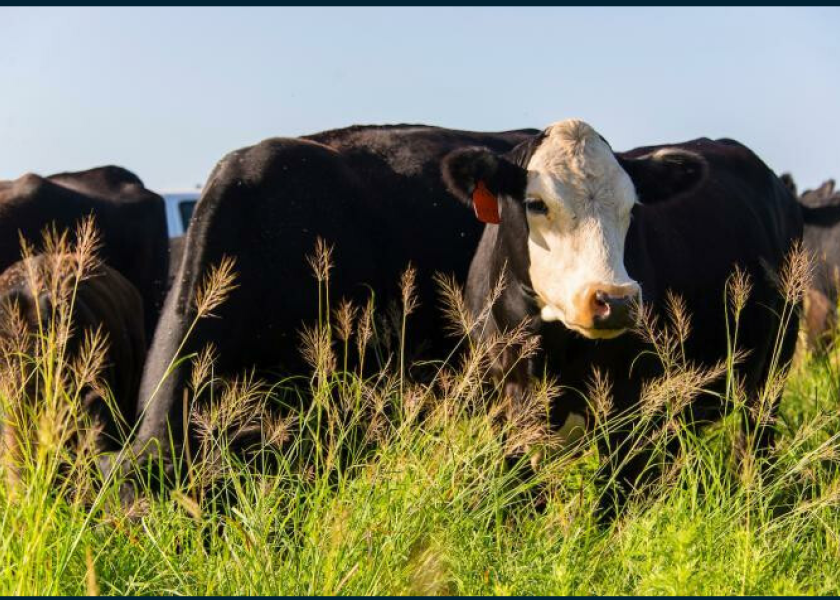Tackle Tough Weeds in Pastures Like you Would in Corn and Soybeans

Farmers routinely tackle tough weed problems in corn and soybeans, understanding that crops yield better with less competition for moisture, nutrients and sunlight.
The same is true for forages, according to Scott Flynn. He encourages producers to view their operations as profit-per-acre businesses, rather than focusing on the price they get for an individual animal.
The shift in mindset requires producers to evaluate the number of pounds of beef they produce per acre of pasture.
“Forages are the cheapest source of energy available and key to our economic success,” explains Flynn, a Missouri-based field scientist for Corteva Agriscience.
He estimates it costs 45 cents a day to feed a cow or steer on pasture, while feeding hay costs considerably more. It’s why Flynn encourages producers to evaluate their pasture weed-control measures.
“For every pound of weed pressure in a field, you remove 1 lb. to 1.5 lb. of forage production, so losses can quickly add up,” he explains.
“By eliminating weeds, the producer often has more options. They could choose to increase the number of cattle on pasture to take advantage of the increased forage available, or they might extend the grazing period further into the fall and save some dollars in feed costs,” he adds.
Here are five weed-control considerations that can help you add more pounds of beef per acre.
1. Identify and address the specific weed species in your fields. This is the single most important step to take, says Glenn Detweiler, North Carolina Extension area agent. He says to walk pastures several times over the course of the growing season to identify and locate weeds.
Record the weeds you have, along with when and where you see them, which can help you evaluate how well your weed-control program is working. In the process, keep in mind that weed species differ on when they emerge. For instance, biennial and winter annual weeds begin to emerge in late summer and fall, notes J.D. Green, University of Kentucky Extension weed scientist.
“You can treat some problem weeds, like musk thistle and poison hemlock, into October and sometimes even November as long as daytime temperatures are above 60 degrees F°,” he says. “2,4-D does a pretty good job on those weeds when they’re in the younger vegetative growth stages and actively growing.”
If not treated this fall, address cool-season weedy species in the early spring while plants are still small, adds Daren Redfearn, University of Nebraska Extension forage and crop residue specialist.
2. Consider interseeding to thicken forage stands. Green says that summer annual weeds, such as common ragweed and cocklebur and even weedy grasses like foxtail, are indications you may have a thin stand of desirable forages. “If you can get out there this fall and interseed, that’s ideal for thickening up desirable forage grasses so they can better compete with weeds next season,” he says. “Spring interseeding is a good time for thickening grass forage stands with clovers,” he adds.
3. Don’t neglect soil fertility. Forages with adequate fertility and soil pH levels are healthier, and therefore, more competitive against opportunistic weeds, Green says.
4. Evaluate your grazing practices and pasture rotation schedule. Over-grazing weakens forages and opens the door to weed growth. Under-grazing allows cattle to be more selective about what they consume, allowing less-desirable weedy plants to flourish. Redfearn says using pasture rotation can help you adjust the area available to cattle for grazing and minimize the opportunity for either issue.
For cool-season grasses, Flynn recommends keeping at least 3” of grass. For warm-season grasses, keep at least 6” to 8” of growth.
“At that point, allow the forage to recover a bit,” he says. “I’ve seen the practice of resting actually double the amount of forage available. A great saying that I like and that’s so true is ‘grass grows grass.’”
5. Consider multiple approaches to weed control. Mowing, herbicide applications and even the use of goats and sheep can sometimes be useful to addressing weed problems in pasture. If you wonder whether it’s time to use a herbicide, one way to evaluate return-on-investment is to evaluate the ratio of weeds to forage.
“We find that if 25% to 30%, of your herbage in the field is made up of non-desirable species – that if we can get those under control and convert that back over to forage biomass – it would justify spending upwards of $20 to $25 an acre for a herbicide and the application,” Flynn says.
nn.







